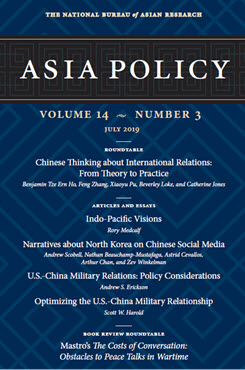Optimizing the U.S.-China Military-to-Military Relationship
This article examines the history, goals, means, and outcomes of the U.S.-China military-to-military relationship and offers suggestions for how the U.S. military can optimize its contacts with the People’s Liberation Army (PLA).
Executive Summary
MAIN ARGUMENT
Questions about the value of U.S. military engagement with the PLA have grown in recent years. A review of contacts between the two sides finds that while the U.S. has largely accomplished its goals of sending authoritative messages and learning about the PLA, it has been less successful at minimizing the risks of unintended conflict and cooperating on common challenges and least successful at shaping China’s emergence through military-to-military engagement. China’s efforts to learn from the U.S. military through direct contact do not appear to have achieved much operationally; however, China has also sought to use military-to-military contacts to raise concerns among U.S. allies about Washington’s reliability and increase symbolic recognition of the PLA as a respected peer military.
POLICY IMPLICATIONS
- The Department of Defense should conduct a formal, public review of U.S. military contacts with China to establish each country’s aims and assess how the two sides measure up in meeting their goals, as well as to ensure that contacts are not resulting in the leakage of sensitive information.
- The Department of Defense should allocate more resources to intelligence and counterintelligence training for U.S. military personnel engaging with Chinese counterparts.
- The Department of Defense should continue to prioritize coordinated messaging with the Department of State so as to ensure that Chinese attempts to induce doubt in U.S. allies about Washington’s reliability do not succeed.
- The U.S. should also seek to expand risk reduction and crisis communications mechanisms with the PLA while also striving to multilateralize such measures so that the benefits of these can be shared with U.S. allies.
- The U.S. should maintain the ban on China’s participation in the Rim of the Pacific exercise until China’s military behavior complies with international norms, international law, and other commitments.
- As Washington adopts a more competitive approach focused on conveying deterrence signals, the U.S. should maintain its most authoritative military-to-military channels to ensure that it can credibly communicate its intentions at the highest levels.
Scott W. Harold is the Associate Director of the Center for Asia Pacific Policy and a Senior Political Scientist at the RAND Corporation, as well as a member of the Pardee RAND Graduate School faculty. In addition to his work at RAND, he is an Adjunct Professor in the Security Studies Program in the Edmund A. Walsh School of Foreign Service at Georgetown University, where he has taught since 2006; an Adjunct Professor of International Affairs at Columbia University; and an Adjunct Professor of International Affairs at the George Washington University.
About Asia Policy
Asia Policy is a peer-reviewed scholarly journal presenting policy-relevant academic research on the Asia-Pacific that draws clear and concise conclusions useful to today’s policymakers. Asia Policy is published quarterly in January, April, July, and October and accepts submissions on a rolling basis. Learn more


